-
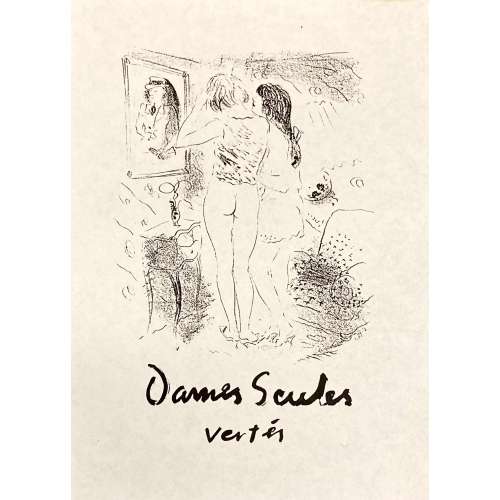 1st edition, limited to 52 copies of which 7 copies on Japon paper (№ 1-7) and 45 copies on Rives paper (№ 8-52); printed by Maurice Daratiere; this copy is № 50. “Ladies only” – a pictorial album, unbound, printed by Maurice Darantiere, with 15 black and white lithographs by Edouard Duchâtel (French, 19th-20th century) after drawings by Marcel Vertès on cream wove paper 38 x 28 cm; French flapped wrappers, with the lithographed manuscript title “Dames seules” in a grey clamshell box 40 x 30 cm; printed by Maurice Darantiere, title with vignette pasted to box cover, one image on a double sheet; all illustrations with tissue guards. Bookplate “From the Library of | Vance Gerry | The Weather Bird Press | pasted inside the box cover (see Vance Gerry and The Weather Bird Press). Provenance: Vance Bryden Gerry (American, 1929 – 2005) Contributors: Marcel Vertès [Marcell Vértes] (Jewish-Hungarian-French, 1895 – 1961) – artist. Francis Carco [François Carcopino-Tusoli] (French, 1886 – 1958) – author. Edouard Duchâtel (French, 19th-20th century) – artist, lithographer. Maurice Darantiere (French, 1882 – 1962) – printer. Louis Godefroy (French, 1885 – 1934) – publisher. Other names: Marcel Vertès, Marcel Vertes, Marcell Vértes
1st edition, limited to 52 copies of which 7 copies on Japon paper (№ 1-7) and 45 copies on Rives paper (№ 8-52); printed by Maurice Daratiere; this copy is № 50. “Ladies only” – a pictorial album, unbound, printed by Maurice Darantiere, with 15 black and white lithographs by Edouard Duchâtel (French, 19th-20th century) after drawings by Marcel Vertès on cream wove paper 38 x 28 cm; French flapped wrappers, with the lithographed manuscript title “Dames seules” in a grey clamshell box 40 x 30 cm; printed by Maurice Darantiere, title with vignette pasted to box cover, one image on a double sheet; all illustrations with tissue guards. Bookplate “From the Library of | Vance Gerry | The Weather Bird Press | pasted inside the box cover (see Vance Gerry and The Weather Bird Press). Provenance: Vance Bryden Gerry (American, 1929 – 2005) Contributors: Marcel Vertès [Marcell Vértes] (Jewish-Hungarian-French, 1895 – 1961) – artist. Francis Carco [François Carcopino-Tusoli] (French, 1886 – 1958) – author. Edouard Duchâtel (French, 19th-20th century) – artist, lithographer. Maurice Darantiere (French, 1882 – 1962) – printer. Louis Godefroy (French, 1885 – 1934) – publisher. Other names: Marcel Vertès, Marcel Vertes, Marcell Vértes -
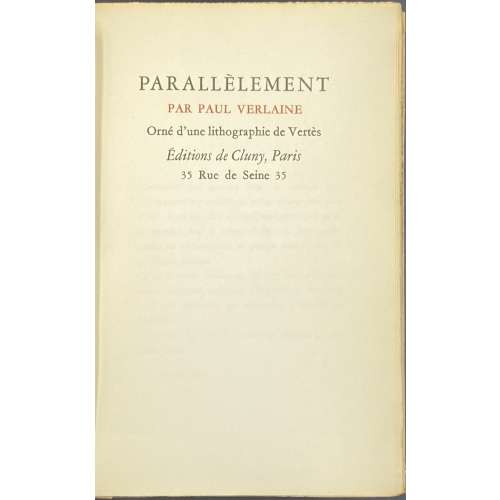 Title-page (in red and black): PARALLELEMENT | PAR PAUL VERLAINE | Orné d’une lithographie de Vertès | Éditions de Cluny, Paris | 35 Rue de Seine 35 || Description: 18.8 x 12.4 cm, French flapped cream wrappers lettered to front and spine, 1st blank leaf, [1-2] h.t. in red / limitation, 3-4] t.p. / blank, 5-127 [128], last blank leaf, plus frontispiece (colour lithography) by Marcel Vertès. Edition: printed on December 5, 1934, by Ducros & Colas in Paris, limited to 2 copies on Japon Nacré (A and B); 3,000 copies on Vergé de Voiron (1-3,000); and several not for sale copies on Papier d’Arches, numbered with Roman numbers. This copy is №282. Contributors: Paul Verlaine (French, 1844 – 1896) – author. Marcel Vertès [Marcell Vértes] (Jewish-Hungarian-French, 1895 – 1961) – artist. Maitres-imprimeurs Ducros et Colas (Paris) – printer. Éditions de Cluny (Paris) – publisher. Other names: Marcel Vertès, Marcel Vertes, Marcell Vértes
Title-page (in red and black): PARALLELEMENT | PAR PAUL VERLAINE | Orné d’une lithographie de Vertès | Éditions de Cluny, Paris | 35 Rue de Seine 35 || Description: 18.8 x 12.4 cm, French flapped cream wrappers lettered to front and spine, 1st blank leaf, [1-2] h.t. in red / limitation, 3-4] t.p. / blank, 5-127 [128], last blank leaf, plus frontispiece (colour lithography) by Marcel Vertès. Edition: printed on December 5, 1934, by Ducros & Colas in Paris, limited to 2 copies on Japon Nacré (A and B); 3,000 copies on Vergé de Voiron (1-3,000); and several not for sale copies on Papier d’Arches, numbered with Roman numbers. This copy is №282. Contributors: Paul Verlaine (French, 1844 – 1896) – author. Marcel Vertès [Marcell Vértes] (Jewish-Hungarian-French, 1895 – 1961) – artist. Maitres-imprimeurs Ducros et Colas (Paris) – printer. Éditions de Cluny (Paris) – publisher. Other names: Marcel Vertès, Marcel Vertes, Marcell Vértes -
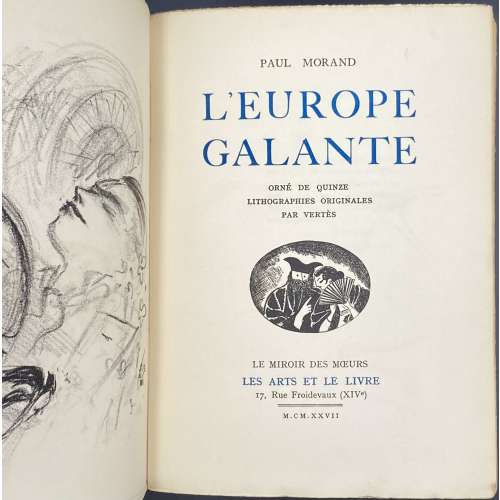 Front wrapper (in black and blue): PAUL MORAND | L'EUROPE | GALANTE | QUINZE LITHOGRAPHES | HORS TEXTE ORIGINALES | DE VERTÈS | {vignette} | LE MIROIR DES MŒURS | LES ARTS ET LE LIVRE | =| M. CM. XXVII || Title-page (in black and blue): PAUL MORAND | L'EUROPE | GALANTE | ORNÉ DE QUINZE | LITHOGRAPHES ORIGINALES | PAR VERTÈS | {vignette} | LE MIROIR DES MŒURS | LES ARTS ET LE LIVRE | 17 Rue Froidevaux (XIVe) | =| M. CM. XXVII || Pagination: [1-9] 10-245 [7], and 2 leaves under the wrappers, ils. Collation: 8vo; [1]8 2-168; first and last leaves under wrappers; total 128 leaves and 17 plates extraneous to collation (two more than the declared 15). Binding: 20.5 x 14.5, French flapped tan wrappers with lettering and vignette, lettering to spine. Printed on May 30, 1927 at l'Imprimerie du Livre, Rueil (Henri Filipacchi, director); under supervision of Georges-Célestin Crès. Edition: 3rd book is the series "Le miroir des mœurs", limited to 1165 copies of which 65 on Papier d'Annam, 15 of them not for sale, numbered 1-50 and 51-65, respectively; 1100 copies on Vélin teinté de Rives (100 of them not for sale), numbered 66-1065 and 1066-1165, respectively. This copy is № 474. Contributors: Paul Morand (French, 1888 – 1976) – author. Marcel Vertès [Marcell Vértes] (Jewish-Hungarian-French, 1895 – 1961) – artist. Les arts et le livre; Georges-Célestin Crès (French, 1875 – 1935) – publisher. l'Imprimerie du Livre (Rueil); Henri Élie Michel Filipacchi [Flippaki] (French, 1900 – 1961) – printer. Other names: Marcel Vertès, Marcel Vertes, Marcell Vértes
Front wrapper (in black and blue): PAUL MORAND | L'EUROPE | GALANTE | QUINZE LITHOGRAPHES | HORS TEXTE ORIGINALES | DE VERTÈS | {vignette} | LE MIROIR DES MŒURS | LES ARTS ET LE LIVRE | =| M. CM. XXVII || Title-page (in black and blue): PAUL MORAND | L'EUROPE | GALANTE | ORNÉ DE QUINZE | LITHOGRAPHES ORIGINALES | PAR VERTÈS | {vignette} | LE MIROIR DES MŒURS | LES ARTS ET LE LIVRE | 17 Rue Froidevaux (XIVe) | =| M. CM. XXVII || Pagination: [1-9] 10-245 [7], and 2 leaves under the wrappers, ils. Collation: 8vo; [1]8 2-168; first and last leaves under wrappers; total 128 leaves and 17 plates extraneous to collation (two more than the declared 15). Binding: 20.5 x 14.5, French flapped tan wrappers with lettering and vignette, lettering to spine. Printed on May 30, 1927 at l'Imprimerie du Livre, Rueil (Henri Filipacchi, director); under supervision of Georges-Célestin Crès. Edition: 3rd book is the series "Le miroir des mœurs", limited to 1165 copies of which 65 on Papier d'Annam, 15 of them not for sale, numbered 1-50 and 51-65, respectively; 1100 copies on Vélin teinté de Rives (100 of them not for sale), numbered 66-1065 and 1066-1165, respectively. This copy is № 474. Contributors: Paul Morand (French, 1888 – 1976) – author. Marcel Vertès [Marcell Vértes] (Jewish-Hungarian-French, 1895 – 1961) – artist. Les arts et le livre; Georges-Célestin Crès (French, 1875 – 1935) – publisher. l'Imprimerie du Livre (Rueil); Henri Élie Michel Filipacchi [Flippaki] (French, 1900 – 1961) – printer. Other names: Marcel Vertès, Marcel Vertes, Marcell Vértes -
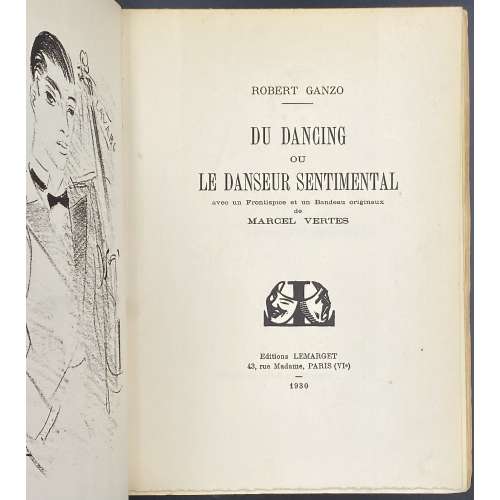 Title-page: ROBERT GANZO | DU DANCING | OU | LE DANSEUR SENTIMENTAL | avec un Frontispice et un Bandeau originaux | de | MARCEL VERTES | {publisher’s device} | Editions LEMARGET | 43, rue Madame, PARIS (VIe) | 1930.|| Description: 20.7 x 14.9 cm, French flapped cream wrappers with black and green lettering similar to title, lettering to spine “DU DANCING”; [1-13] incl. leaf in wrapper, 1st blank leaf, h.t. / limitation, frontispiece, t.p. / copyright, dedication to Gaston Guillot / blank, 14-106 [4] colophon / blank, and one leaf in wrapper; frontispiece and first chapter headpiece lithography by Vertès, plus inset of the same. Collation: 4to; [1,2]4 3-134 143; total 55 leaves. Printing: June 10, 1930, by Presses Modernes in Reims. Edition: 15 copies on Japon Impérial numbered I-XV, 20 colies on Hollande Van Gelder numbered XVI-XXXV, 250 copies on Vélin de Rives numbered 1-250, 20 of which reserved for the bookstore of H. Champion, and 25 presentation copies numbered A-Z. This copy is № XVI. Contributors: Robert Ganzo (French, 1898 – 1995) – author. Marcel Vertès [Marcell Vértes] (Jewish-Hungarian-French, 1895 – 1961) – artist. Gaston Guillot (French, 1889 – 1960) – dedicatee. Editions Lemarget (Paris) – publisher. Presses Modernes (Reims) – printer. Other names: Marcel Vertès, Marcel Vertes, Marcell Vértes
Title-page: ROBERT GANZO | DU DANCING | OU | LE DANSEUR SENTIMENTAL | avec un Frontispice et un Bandeau originaux | de | MARCEL VERTES | {publisher’s device} | Editions LEMARGET | 43, rue Madame, PARIS (VIe) | 1930.|| Description: 20.7 x 14.9 cm, French flapped cream wrappers with black and green lettering similar to title, lettering to spine “DU DANCING”; [1-13] incl. leaf in wrapper, 1st blank leaf, h.t. / limitation, frontispiece, t.p. / copyright, dedication to Gaston Guillot / blank, 14-106 [4] colophon / blank, and one leaf in wrapper; frontispiece and first chapter headpiece lithography by Vertès, plus inset of the same. Collation: 4to; [1,2]4 3-134 143; total 55 leaves. Printing: June 10, 1930, by Presses Modernes in Reims. Edition: 15 copies on Japon Impérial numbered I-XV, 20 colies on Hollande Van Gelder numbered XVI-XXXV, 250 copies on Vélin de Rives numbered 1-250, 20 of which reserved for the bookstore of H. Champion, and 25 presentation copies numbered A-Z. This copy is № XVI. Contributors: Robert Ganzo (French, 1898 – 1995) – author. Marcel Vertès [Marcell Vértes] (Jewish-Hungarian-French, 1895 – 1961) – artist. Gaston Guillot (French, 1889 – 1960) – dedicatee. Editions Lemarget (Paris) – publisher. Presses Modernes (Reims) – printer. Other names: Marcel Vertès, Marcel Vertes, Marcell Vértes -
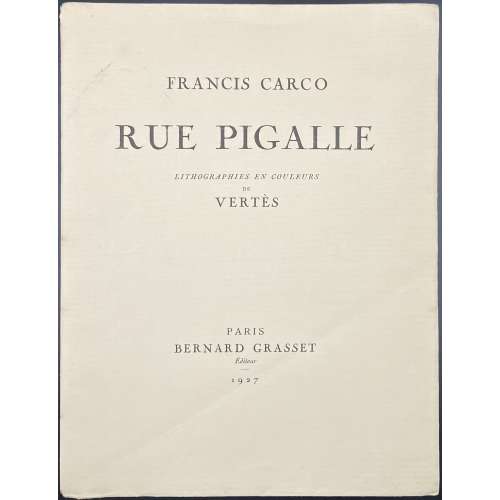 Title-page: FRANCIS CARCO | RUE PIGALLE | LITHOGRAPHIES EN COULEURS | DE | VERTÈS | PARIS | BERNARD GRASSET | Éditeur | 1927 || Description: 25.7 x 19.5 cm, French flapped cream wrappers with black lettering similar to title, lettering to spine, [2] 1st blank leaf, [2] h.t. / blank, plate / blank, [2] t.p. /blank, dedication “A | FRED ANTOINE ANGERMAYER” / blank, [1-2] d.t.p. “CHAPITRE | PREMIER” / blank, [3] 4-124, [2] limitation / blank, [2] last blank leaf; collation: 4to; π4 1-164; total 68 leaves and 14 plates printed by Frères Mourlot after watercolours by Marcel Vertès. Printing : September 15, 1927 by Coulouma in Argenteuil (H. Barthélemy, director); plates printed by Frères Mourlot in Paris; Edition: print run limited to 338 copies of which 22 on Japon Impérial (numbered Japon 1-15 and I-VII) enriched with one original watercolour drawing, one suite in black and one in colour, etc.; 43 copies on Hollande van Gelder (Hollande 1-33 and I-X) with additional suites in black and in colour; 270 copies on Vélin d’Arches (Arches 1-250 and I-XX); and 3 “special” copies. This copy is numbered Arches № 162. Contributors: Francis Carco [François Carcopino-Tusoli] (French, 1886 – 1958) – author. Marcel Vertès [Marcell Vértes] (Jewish-Hungarian-French, 1895 – 1961) – artist. Frères Mourlot – lithographer. Robert Coulouma (French, 1887 – 1976) – printer. Bernard Grasset (French, 1881 – 1955) – publisher. Fred Antoine Angermayer (German, 1889 –1951) – dedicatee. Other names: Marcel Vertès, Marcel Vertes, Marcell Vértes
Title-page: FRANCIS CARCO | RUE PIGALLE | LITHOGRAPHIES EN COULEURS | DE | VERTÈS | PARIS | BERNARD GRASSET | Éditeur | 1927 || Description: 25.7 x 19.5 cm, French flapped cream wrappers with black lettering similar to title, lettering to spine, [2] 1st blank leaf, [2] h.t. / blank, plate / blank, [2] t.p. /blank, dedication “A | FRED ANTOINE ANGERMAYER” / blank, [1-2] d.t.p. “CHAPITRE | PREMIER” / blank, [3] 4-124, [2] limitation / blank, [2] last blank leaf; collation: 4to; π4 1-164; total 68 leaves and 14 plates printed by Frères Mourlot after watercolours by Marcel Vertès. Printing : September 15, 1927 by Coulouma in Argenteuil (H. Barthélemy, director); plates printed by Frères Mourlot in Paris; Edition: print run limited to 338 copies of which 22 on Japon Impérial (numbered Japon 1-15 and I-VII) enriched with one original watercolour drawing, one suite in black and one in colour, etc.; 43 copies on Hollande van Gelder (Hollande 1-33 and I-X) with additional suites in black and in colour; 270 copies on Vélin d’Arches (Arches 1-250 and I-XX); and 3 “special” copies. This copy is numbered Arches № 162. Contributors: Francis Carco [François Carcopino-Tusoli] (French, 1886 – 1958) – author. Marcel Vertès [Marcell Vértes] (Jewish-Hungarian-French, 1895 – 1961) – artist. Frères Mourlot – lithographer. Robert Coulouma (French, 1887 – 1976) – printer. Bernard Grasset (French, 1881 – 1955) – publisher. Fred Antoine Angermayer (German, 1889 –1951) – dedicatee. Other names: Marcel Vertès, Marcel Vertes, Marcell Vértes -
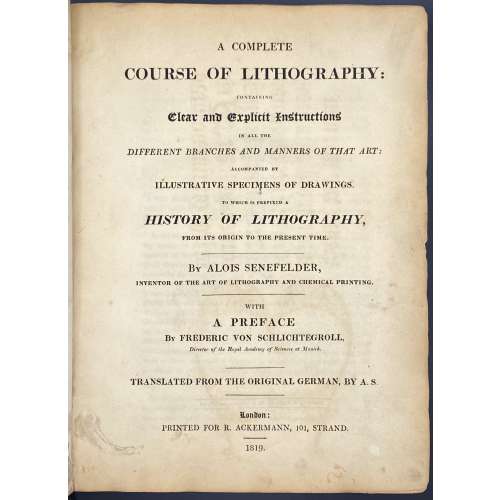 Title: A COMPLETE | COURSE OF LITHOGRAPHY: | CONTAINING | Clear and Explicit Instructions | IN ALL THE | DIFFERENT BRANCHES AND MANNERS OF THAT ART | ACCOMPANIED BY | ILLUSTRATIVE SPECIMENS OF DRAWINGS. | TO WHICH IS PREFIXED A | HISTORY OF LITHOGRAPHY, | FROM ITS ORIGIN TO THE PRESENT TIME. | By ALOIS SENEFELDER, | INVENTOR OF THE ART OF LITHOGRAPHY AND CHEMICAL PRINTING. | WITH | A PREFACE | By FREDERIC VON SCHLICHTEGROLL, |Director of the Royal Academy of Sciences at Munich. | TRANSLATED FROM THE ORIGINAL GERMAN, BY A.S. | London: | PRINTED FOR R. ACKERMANN, 101 STRAND. | 1819. || Pagination: [i-iii] iv-xxviii, [4] [1] 2-342. Collation: 4to; [a]-d4, B-2U4 2X2, +14 lithographed plates by Ackermann (incl. 1 folding, 1 colour frontispiece and 1 portrait of A. Senefelder); plates opposite to pp. [i], [1], 193, 198, 203, 228, 232 (fold.), 256, 258, 264, 269, 290, 302, and 305. Binding: By Anne Krawitz (Philadelphia, PA), 27.5 x 21 cm, modern full mottled calf, boards ruled in gilt, flat spine, compartments ruled in gilt, crimson label with gilt lettering to spine, printed on wove paper; round book-plate to front paste-down “TWM, The Whitehead Library”. Edition: 1st in English. Ref.: MET: Accession Number: Ref.20; RCT: RCIN 1195886; Contributors: Alois Senefelder (German, 1771 – 1834) – author of the original and translator. Friedrich Schlichtegroll (German, 1765 – 1822) – author of preface. William Clowes (British, 1779 – 1847) – printer. Rudolph Ackermann (German-British, 1764 – 1834) – publisher and lithographer. Samuel Prout (British, 1783 – 1852) Maximilian Joseph, King of Bavaria (German, 1756 –1825) – dedicatee.
Title: A COMPLETE | COURSE OF LITHOGRAPHY: | CONTAINING | Clear and Explicit Instructions | IN ALL THE | DIFFERENT BRANCHES AND MANNERS OF THAT ART | ACCOMPANIED BY | ILLUSTRATIVE SPECIMENS OF DRAWINGS. | TO WHICH IS PREFIXED A | HISTORY OF LITHOGRAPHY, | FROM ITS ORIGIN TO THE PRESENT TIME. | By ALOIS SENEFELDER, | INVENTOR OF THE ART OF LITHOGRAPHY AND CHEMICAL PRINTING. | WITH | A PREFACE | By FREDERIC VON SCHLICHTEGROLL, |Director of the Royal Academy of Sciences at Munich. | TRANSLATED FROM THE ORIGINAL GERMAN, BY A.S. | London: | PRINTED FOR R. ACKERMANN, 101 STRAND. | 1819. || Pagination: [i-iii] iv-xxviii, [4] [1] 2-342. Collation: 4to; [a]-d4, B-2U4 2X2, +14 lithographed plates by Ackermann (incl. 1 folding, 1 colour frontispiece and 1 portrait of A. Senefelder); plates opposite to pp. [i], [1], 193, 198, 203, 228, 232 (fold.), 256, 258, 264, 269, 290, 302, and 305. Binding: By Anne Krawitz (Philadelphia, PA), 27.5 x 21 cm, modern full mottled calf, boards ruled in gilt, flat spine, compartments ruled in gilt, crimson label with gilt lettering to spine, printed on wove paper; round book-plate to front paste-down “TWM, The Whitehead Library”. Edition: 1st in English. Ref.: MET: Accession Number: Ref.20; RCT: RCIN 1195886; Contributors: Alois Senefelder (German, 1771 – 1834) – author of the original and translator. Friedrich Schlichtegroll (German, 1765 – 1822) – author of preface. William Clowes (British, 1779 – 1847) – printer. Rudolph Ackermann (German-British, 1764 – 1834) – publisher and lithographer. Samuel Prout (British, 1783 – 1852) Maximilian Joseph, King of Bavaria (German, 1756 –1825) – dedicatee. -
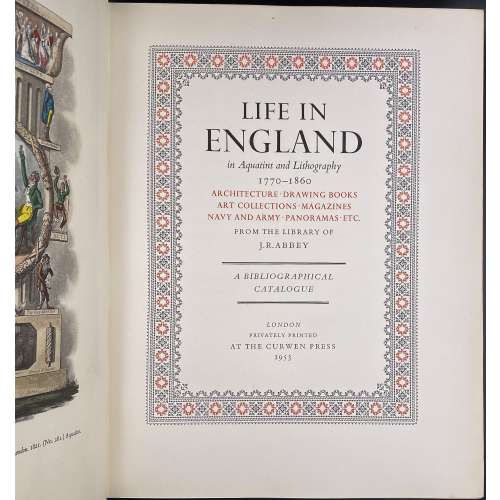 Title in black and red: LIFE IN ENGLAND | in Aquatint and Lithography | 1770—1860 | ARCHITECTURE • DRAWING BOOKS | ART COLLECTIONS • MAGAZINES | NAVY AND ARMY • PANORAMAS ETC. | FROM THE LIBRARY OF J. R. ABBEY | — | A BIBLIOGRAPHICAL | CATALOGUE | — | LONDON | PRIVATELY PRINTED | AT THE CURWEN PRESS | 1953 || Pagination: 2 blank leaves, [2] – limited edition 114 of 400 / blank, [i, ii] – h.t. / blank, [2] blank / frontis., [iii, iv] – t.p. / printer, v – contents, [vi] –blank, vii-ix – list of plates, [x] – blank, xi-xiii – list of ill., [xiv] – blank, xv-xxi – preface, xxii – blank; [1, 2] f.t. / blank, 3-427 [428], 2 blank leaves. Binding: Hardcover, 32 x 25.5 x 6.5 cm; brown cloth, red label with gilt lettering to spine, tan DJ with lettering to front and spine.
Title in black and red: LIFE IN ENGLAND | in Aquatint and Lithography | 1770—1860 | ARCHITECTURE • DRAWING BOOKS | ART COLLECTIONS • MAGAZINES | NAVY AND ARMY • PANORAMAS ETC. | FROM THE LIBRARY OF J. R. ABBEY | — | A BIBLIOGRAPHICAL | CATALOGUE | — | LONDON | PRIVATELY PRINTED | AT THE CURWEN PRESS | 1953 || Pagination: 2 blank leaves, [2] – limited edition 114 of 400 / blank, [i, ii] – h.t. / blank, [2] blank / frontis., [iii, iv] – t.p. / printer, v – contents, [vi] –blank, vii-ix – list of plates, [x] – blank, xi-xiii – list of ill., [xiv] – blank, xv-xxi – preface, xxii – blank; [1, 2] f.t. / blank, 3-427 [428], 2 blank leaves. Binding: Hardcover, 32 x 25.5 x 6.5 cm; brown cloth, red label with gilt lettering to spine, tan DJ with lettering to front and spine. -
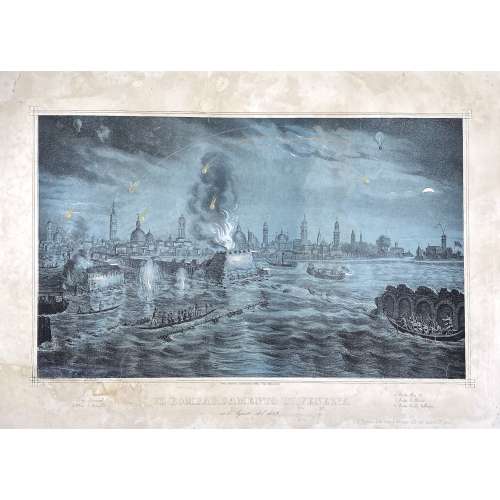 Quaritch's description: Single sheet (435 x 625 mm); coloured lithograph by Kirchmayr after a drawing by M. Fontana; hand-painted details; signed to lower left ‘M. Fon[tana]’ and to lower right ‘M. Fontana Edit. Prop. S. Giacomo dall’Orio in Isola N°.1481’; lower margin with the title ‘Il bombardamento di Venezia nell’Agosto 1849’ and key; restored tears in many places, especially along upper and lower blank margins, some affecting print; losses to lower left corner, affecting a small portion of the print, ruled border, and key, restored and re-drawn where needed; loss to the upper left corner of blank margin; two small areas of restoration to the centre of upper blank margin; the whole sheet backed; nevertheless a remarkable survival. Exceedingly rare and striking lithograph of Venice as seen from Fusina, depicting the first ever aerial bombardment in history. The bombardment took place in 1849, under the orders of Field Marshal Josef Radetzky (1766–1858), to quell the revolts that had started the previous year during the First Italian War of Independence. This curious and little-known action was the brainchild of Colonel Benno Uchatius, a brilliant young officer in the Austro-Hungarian Artillery. After long months of unsuccessful siege, Uchatius decided to deploy an unusual weapon: a hot air balloon able to bomb the city from above. Having calculated the wind speed and direction and evaluated the requisite dimensions of the hot-air balloon, Uchatius set up a workshop near Mestre, where a group of engineers and craftsmen began to manufacture a balloon equipped with a large wicker basket which could transport two crewmen and approximately one hundred kilograms of small long-fuse devices (metal spheres filled with gunpowder, pitch, oil and five hundred rifle buckshot). The initial trials, however, proved to be a disaster, because the balloon would drift off course, making it impossible to accurately deploy the bombs. Uchatius then hit upon the idea of using several smaller unmanned balloons roped together. These were to be launched over the city and, using the position of the first ‘pilot’ balloon, which was unarmed, the Austrians could calculate the correct fuse settings for the bombs. The ‘bomber’ balloons had a cloth envelope of one hundred cubic metres and a reduced load of about twenty kilograms of ordnance. According to Uchatius’ calculations, the line of balloons, launched from Mestre, would reach the lagoon city in thirty-five to forty minutes, carried by the north-west wind. In July 1849, a first launch was attempted, but when a breeze began to blow from the sea some of the balloons broke the connecting ropes and floated away, while others settled in the water in front of the northern part of the city, where a curious crowd of Venetians observed the failure of the enterprise and commented colourfully on the ‘buffoonery of Radetzky’. Uchatius’ second attempt, which is depicted in this lithograph, was also largely unsuccessful: only a few of the unmanned bomber balloons reached their target, and some even drifted back over the Austrian lines. Uchatius, having accomplished the first ever aerial bombardment, and having designed the first ever military ‘drones’, was forced to abandon the project permanently. Another fascinating aspect of this work is the vantage point used to depict the city of Venice, seen here from Fusina, a very rare viewpoint that makes this piece even more remarkable. We were unable to locate any copies in any institution or bibliography. G. Kirchmayr (fl. mid-19th century) is mentioned at British Museum database as "Lithographer active in Venice; related to Venetian painter Cherubino Kirchmayr (b. 1848)?" However, I was not able to find that name on the print. Not much is known of M. Fontana either.
Quaritch's description: Single sheet (435 x 625 mm); coloured lithograph by Kirchmayr after a drawing by M. Fontana; hand-painted details; signed to lower left ‘M. Fon[tana]’ and to lower right ‘M. Fontana Edit. Prop. S. Giacomo dall’Orio in Isola N°.1481’; lower margin with the title ‘Il bombardamento di Venezia nell’Agosto 1849’ and key; restored tears in many places, especially along upper and lower blank margins, some affecting print; losses to lower left corner, affecting a small portion of the print, ruled border, and key, restored and re-drawn where needed; loss to the upper left corner of blank margin; two small areas of restoration to the centre of upper blank margin; the whole sheet backed; nevertheless a remarkable survival. Exceedingly rare and striking lithograph of Venice as seen from Fusina, depicting the first ever aerial bombardment in history. The bombardment took place in 1849, under the orders of Field Marshal Josef Radetzky (1766–1858), to quell the revolts that had started the previous year during the First Italian War of Independence. This curious and little-known action was the brainchild of Colonel Benno Uchatius, a brilliant young officer in the Austro-Hungarian Artillery. After long months of unsuccessful siege, Uchatius decided to deploy an unusual weapon: a hot air balloon able to bomb the city from above. Having calculated the wind speed and direction and evaluated the requisite dimensions of the hot-air balloon, Uchatius set up a workshop near Mestre, where a group of engineers and craftsmen began to manufacture a balloon equipped with a large wicker basket which could transport two crewmen and approximately one hundred kilograms of small long-fuse devices (metal spheres filled with gunpowder, pitch, oil and five hundred rifle buckshot). The initial trials, however, proved to be a disaster, because the balloon would drift off course, making it impossible to accurately deploy the bombs. Uchatius then hit upon the idea of using several smaller unmanned balloons roped together. These were to be launched over the city and, using the position of the first ‘pilot’ balloon, which was unarmed, the Austrians could calculate the correct fuse settings for the bombs. The ‘bomber’ balloons had a cloth envelope of one hundred cubic metres and a reduced load of about twenty kilograms of ordnance. According to Uchatius’ calculations, the line of balloons, launched from Mestre, would reach the lagoon city in thirty-five to forty minutes, carried by the north-west wind. In July 1849, a first launch was attempted, but when a breeze began to blow from the sea some of the balloons broke the connecting ropes and floated away, while others settled in the water in front of the northern part of the city, where a curious crowd of Venetians observed the failure of the enterprise and commented colourfully on the ‘buffoonery of Radetzky’. Uchatius’ second attempt, which is depicted in this lithograph, was also largely unsuccessful: only a few of the unmanned bomber balloons reached their target, and some even drifted back over the Austrian lines. Uchatius, having accomplished the first ever aerial bombardment, and having designed the first ever military ‘drones’, was forced to abandon the project permanently. Another fascinating aspect of this work is the vantage point used to depict the city of Venice, seen here from Fusina, a very rare viewpoint that makes this piece even more remarkable. We were unable to locate any copies in any institution or bibliography. G. Kirchmayr (fl. mid-19th century) is mentioned at British Museum database as "Lithographer active in Venice; related to Venetian painter Cherubino Kirchmayr (b. 1848)?" However, I was not able to find that name on the print. Not much is known of M. Fontana either. -
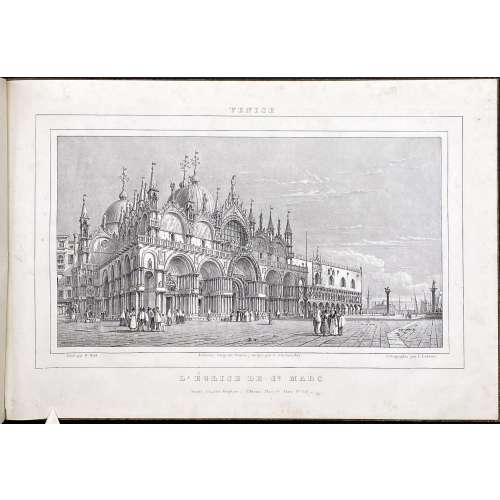 Owner's convolute binding of the period in quarter tan cloth, yellow marbled boards, no title page, no pagination. Contents: (1) Venetian Album –12 lithographs by Émile-Aubert Lessore (French, 1805 – 1876) after William Wyld (British, 1806 – 1889). — Venice: Charles Hopfner, [1834]. Printed at Premiata Litografia Veneta under the direction of Ferdinand Wolfgang Flachenecker (German, 1782 – 1847). Inscription: Premiata Litografia Veneta, dirigée par C. Flachenecker.
Owner's convolute binding of the period in quarter tan cloth, yellow marbled boards, no title page, no pagination. Contents: (1) Venetian Album –12 lithographs by Émile-Aubert Lessore (French, 1805 – 1876) after William Wyld (British, 1806 – 1889). — Venice: Charles Hopfner, [1834]. Printed at Premiata Litografia Veneta under the direction of Ferdinand Wolfgang Flachenecker (German, 1782 – 1847). Inscription: Premiata Litografia Veneta, dirigée par C. Flachenecker.- L'Église de St. Marc
- La place St. Marc
- Le palais Ducal
- Le Môle
- L'Arsenal
- La Riva dei Schiavoni
- Le Grand Canal, (1re vue)
- Le Grand Canal (2me vue)
- Le Grand Canal (3me vue)
- Le Grand Canal (4me vue)
- Le Grand Canal (5me vue)
- Le Grand Canal (6me vue)
- Title: Spiegazione / delli quattro prospetti dei bassi rilievi in marmo che circondano le mura della S. Casa di Loreto / qui annessi in puntata, oltre l'altro prospetto del palazzo pontificio / facciata del tempio, campanile, e cuppola etc.
- Prospetto della Basilica, e Piazza Lauretana, ed annesso Palazzo Apostolico / V. Jaffei incise.
- Settentrione. Prospetto laterale de Bassirilievi in Marmo, che circondano le Mura di S. Casa di Loreto. Jaffei incise Loreto.
- Oriente. Prospetto de Bassirilievi in Marmo, che circ=ondano le Mura di S. Casa. Jaffei incise Loreto l'Anno 1828.
- Mezzo Giorno. Prospetto laterale de Bassirilievi in Marmo, che circondano le Mura di S. Casa di Loreto. Jaffei dis. ed inc. in Loreto.
- Occidente. Prospetto de Bassirilievi in Marmo, che circ=ondano le Mura di S. Casa. Jaffei dis. ed inc. in Loreto l'Anno 1828.
-
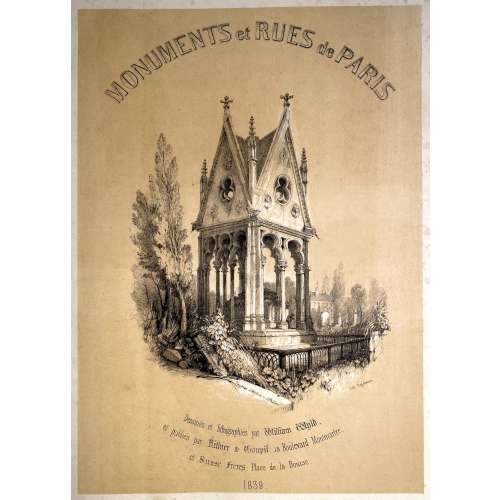 Pictorial album 55.5 x 41.0 cm, publisher’s quarter sheepskin over cloth, upper cover and flat spine lettered in gilt. Title: MONUMENTS et RUES de PARIS | Dessinés et lithographiés par William Wyld, | et publiés par Rittner & Goupil, 15 Boulevard Montmartre, | et Susse Frères, Place de la Bourse. | 1839. Collation: Title plate + 20 plates numbered from 1 to 20, printed by Godefroy Engelmann (French, 1788 – 1839) in tone lithography after drawings by William Wyld (British, 1806 – 1889). Published in Paris by Rittner & Goupil and Susse Frères in 1839. Plates: 54.8 x 39.8 cm. Contents:
Pictorial album 55.5 x 41.0 cm, publisher’s quarter sheepskin over cloth, upper cover and flat spine lettered in gilt. Title: MONUMENTS et RUES de PARIS | Dessinés et lithographiés par William Wyld, | et publiés par Rittner & Goupil, 15 Boulevard Montmartre, | et Susse Frères, Place de la Bourse. | 1839. Collation: Title plate + 20 plates numbered from 1 to 20, printed by Godefroy Engelmann (French, 1788 – 1839) in tone lithography after drawings by William Wyld (British, 1806 – 1889). Published in Paris by Rittner & Goupil and Susse Frères in 1839. Plates: 54.8 x 39.8 cm. Contents:Title page: Tombeau d'Heloïse et d'Abélard
- Le Pont Neuf
- L'église de la Madeleine
- La Porte St. Martin
- Palais des Tuileries
- Pont des Saints-Pères
- Hôtel de Ville
- Marché des Innocents
- Palais Royal
- Boulevard des Italiens
- Rue de la Paix
- Bourse et Tribunal de Commerce
- Porte St. Denis
- Pont Royal
- Place de la Concorde
- Paris from Père Lachaise
- Notre-Dame
- Jardin des Tuileries with Arc de Triomphe in the Distance
- Panthéon
- Chambre des députés
- Arc de Triomphe de l'Étoile


